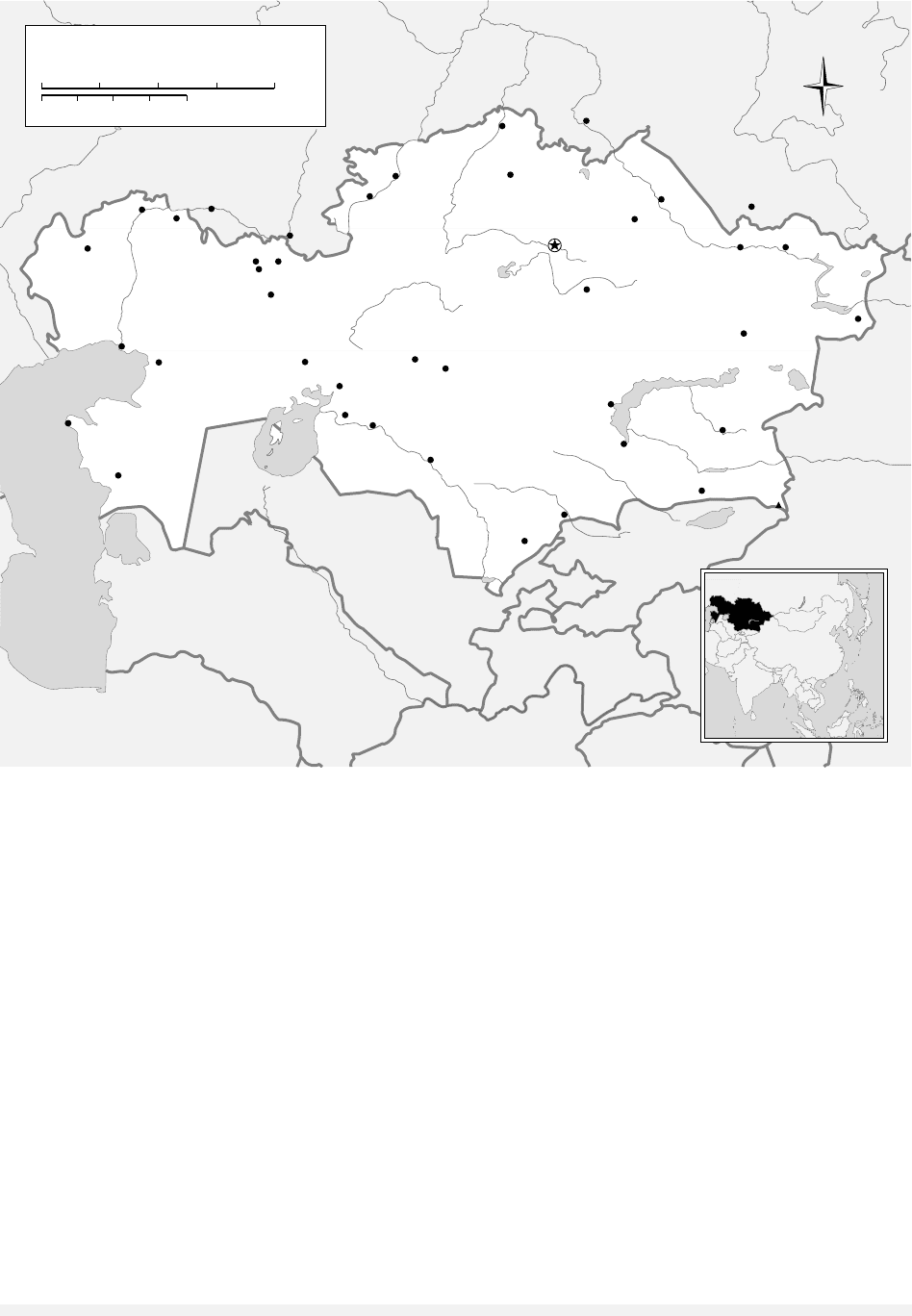Encyclopedia of Russian History
Подождите немного. Документ загружается.


Party and little to do with the SRs. When Lenin was
wounded in August 1918, Kaplan’s nervous be-
havior at the scene led to her arrest, although it
subsequently emerged that no one had actually
witnessed her role in the shooting. She was exe-
cuted within days of being apprehended. Bolshevik
authorities labeled Kaplan an SR and the attempt
on Lenin’s life an SR terrorist conspiracy; SR lead-
ers strongly denied both accusations during their
show trial in 1922.
See also: ANARCHISM; LENIN, VLADIMIR ILICH; SHOW TRI-
ALS; SOCIALIST REVOLUTIONARIES; TERRORISM
BIBLIOGRAPHY
Jansen, Marc. (1982). A Show Trial under Lenin: The Trial
of the Socialist Revolutionaries, Moscow 1922, tr. Jean
Sanders. The Hague: Martinus Nijhoff Publishers.
Lyandres, Semion. (1989). “The 1918 Attempt on the Life
of Lenin: A New Look at the Evidence.” Slavic Review
48(3):432–48.
S
ALLY
A. B
ONIECE
KARACHAI
The Karachai are a small Turkic nationality of the
central North Caucasus. They speak a language
from the Kypchak group of the Altaic language
family and are closely related to the Balkars. They
inhabit high-elevation mountain valleys of the up-
per Kuban and Teberda river basins, and their pas-
tures once stretched up to the peaks and glaciers of
the northern slope of the Great Caucasus moun-
tain range.
Their remote origins can be traced to Kypchak-
speaking pastoralist groups such as the Polovt-
sians, who may have been forced to take refuge
high in the mountains by the Mongol invasions in
thirteenth century. At some point before the six-
teenth century, the Karachai came under the dom-
ination of the princes in Kabarda. The Crimean
khanate claimed nominal jurisdiction over much
of the northwest Caucasus and, correspondingly,
Karachai territories, until its demise in 1782. Con-
version to Islam took place gradually, gaining mo-
mentum during the eighteenth and nineteenth
centuries. A series of military incursions into their
territories motivated several Karachai elders to sign
a capitulation agreement and nonaggression pact
with Russian forces in 1828. Although they were
officially considered subjects of the tsar from that
moment, various forms of resistance to Russian
rule continued until 1864. A Karachai-Cherkess
autonomous region was established in 1922 and
in 1926 was divided into two distinct units.
Karachai territories were occupied by the forces of
Nazi Germany between July 1942 and January
1943. While many Karachai men served in the Red
Army, others joined bandit and anti-Soviet parti-
san groups. In the fall of 1943 the Supreme So-
viet of the USSR ordered the deportation of the
Karachai people for alleged cooperation with the
Germans and participation in organized resistance
to Soviet power. The Karachai autonomous region
was abolished in 1944 and virtually the entire
Karachai population was deported to Kyrgyzstan
and Kazakhstan. In 1956 party members and Red
Army veterans were allowed to return to their
homeland, and in 1957 others were legally given
the right to return. In 1957 the joint Karachai-
Cherkess autonomous region was reestablished
and the mass return of the Karachai was initiated.
After the fall of the Soviet Union, the Karachai-
Cherkess autonomous region became a republic of
the Russian Federation.
Traditionally, Karachais subsisted on a combi-
nation of agriculture and stock-raising. As late as
the first decades of the twentieth century, only one-
fourth of all Karachai had adopted a completely
stationary lifestyle. The rest of the population sea-
sonally relocated from summer to winter pastures
with their herds of horses, cattle, sheep, and goats.
During the Soviet period, the Karachai remained
one of the least urbanized groups: Less than 20 per-
cent lived in cities. Clans were a central component
of traditional Karachai social organization. Al-
though some clans and their elders could be recog-
nized as more prominent or senior than others, the
Karachai did not have a powerful princely elite or
nobility. In the twentieth century the Karachai pop-
ulation grew from about 30,000 to about 100,000.
A Karachai literary language was developed and
standardized in the 1920s.
See also: CAUCASUS; CHERKESS; ISLAM; NATIONALITIES
POLICIES, SOVIET; NATIONALITIES POLICIES, TSARIST
BIBLIOGRAPHY
Wixman, Ronald. (1980). Language Aspects of Ethnic Pat-
terns and Processes in the North Caucasus. Chicago:
University of Chicago.
B
RIAN
B
OECK
KARACHAI
723
ENCYCLOPEDIA OF RUSSIAN HISTORY

KARAKALPAKS
Karakalpaks are a Turkic people who live in Cen-
tral Asia. Of the nearly 500,000 Karakalpaks, more
than 90 percent live in northwestern Uzbekistan,
in the Soviet-created Karakalpak Autonomous Re-
public (KAR). Other Karakalpaks live elsewhere
in Uzbekistan, as well as in Kazakhstan, Turk-
menistan, Russia, and Afghanistan. Most adhere to
Sunni Islam, although Sufi sects have also attracted
many followers. They speak a language that is
closely related to Kazakh and Kyrgyz.
Most historians trace the Karakalpaks’ origins
to Persian and Mongolian peoples living on the
steppes of Central Asia and Southern Russia. Their
name literally meets “black hatted,” and mention
of a tribe thought to be ancestral to today’s
Karakalpaks first appears in Russian chronicles (as
Chorniye Kolbuki) in 1146. Renowned for their
military prowess, this group allied themselves with
the Kievan princes in their battles with other Russ-
ian princes and tribes of the steppes. In the 1200s
some Karakalpaks joined the Mongol Golden Horde,
and by the 1500s they enjoyed a short-lived inde-
pendence. Over time, however, they became sub-
jects of other Central Asian peoples and eventually
the Russians, who pushed into Central Asia in the
1800s.
In 1918 they were included with other Central
Asian peoples in the Turkistan Autonomous Re-
public, and in 1925 a Karakalpak Autonomous
Oblast was created in the Kazakh Autonomous So-
viet Socialist Republic. This oblast eventually be-
came the KAR, and in 1936 it became part of the
Uzbek Soviet Socialist Republic. Under Soviet rule,
Karakalpaks were encouraged to move to the KAR,
their nominal homeland.
The post-Soviet period found most Karakalpaks
desperately poor, living in an environmentally dev-
astated area adjacent to the rapidly shrinking Aral
Sea. Serious health problems such as hepatitis, ty-
phoid, and cancer are widespread. Despite their no-
madic traditions, their economy is dominated by
agriculture, especially cotton production, which
has suffered due to water shortages, soil erosion,
and environmental damage. Because of lack of in-
vestment in the region, the KAR’s relations with the
central Uzbek government have been strained.
See also: CENTRAL ASIA; ISLAM; NATIONALITIES POLICIES,
SOVIET; NATIONALITIES POLICIES, TSARIST; UZBEK-
ISTAN AND UZBEKS
BIBLIOGRAPHY
Hanks, Reuel. (2000). “A Separate Peace? Karakalpak Na-
tionalism and Devolution in Post-Soviet Uzbek-
istan.” Europe-Asia Studies 52: 939–53.
P
AUL
J. K
UBICEK
KARAKHAN DECLARATION
In the Karakhan Manifesto of 1919, the Soviet gov-
ernment offered to annul the unequal treaties im-
posed on China by Imperial Russia. The declaration,
signed by Deputy Commissar of Foreign Affairs Lev
M. Karakhan , included rights of extraterritoriality
for Russians in China, economic concessions, and
Russia’s share of the Boxer rebellion indemnity.
Though dated July 25, 1919, it was not actually
published for another month. Civil war prevented
its delivery to China, but the Beijing authorities
soon learned its substance.
Controversy arose because the document was
prepared in two versions. One variant contained the
statement that “the Soviet Government returns to
the Chinese people, without any compensation, the
Chinese Eastern Railway [CER]. . . .” The version
published in Moscow in August 1919 did not in-
clude this provision, but the copy that was deliv-
ered to Chinese diplomats in February 1920 did
incorporate the offer to return the CER. However,
a Soviet proposal on September 27, 1920, for a
Sino-Russian agreement made no mention of re-
turning the Chinese Eastern Railway, but requested
a new agreement for its joint administration by the
two nations. All subsequent Soviet reprintings of
the Karakhan Manifesto omit the offer to return
the CER, while a Chinese reprinting of the docu-
ment in 1924 included the offer. The existence of
two versions manifests the ambiguity in Soviet pol-
icy toward the Far East in 1919 and 1920, arising
from the unpredictable course of the civil war and
foreign intervention. Thereafter, the consolidation
of Bolshevik power in Siberia, combined with con-
tinuing instability in China, led Moscow to seek
some degree of control over the economically and
strategically important CER.
See also: CHINA, RELATIONS WITH; CIVIL WAR OF
1917–1922; RAILWAYS
BIBLIOGRAPHY
Degras, Jane, ed. (1951). Soviet Documents on Foreign Pol-
icy, Vol. 1: 1917–1924. London: Oxford University
Press.
KARAKALPAKS
724
ENCYCLOPEDIA OF RUSSIAN HISTORY

Leong, Sow-theng. (1976). Sino-Soviet Diplomatic Rela-
tions, 1917–1926. Honolulu: University Press of
Hawaii.
T
EDDY
J. U
LDRICKS
KARAMZIN, NIKOLAI MIKHAILOVICH
(1766–1826), writer, historian, and journalist.
Born in the Simbirsk province and educated in
Moscow, Nikolai Karamzin served only briefly in
the military before retiring to devote himself to in-
tellectual pursuits. In 1789 he undertook a jour-
ney to western Europe, visiting several luminaries,
including Immanuel Kant, on his way. Reaching
Paris in the spring of 1790, he witnessed history
in the making. He described his trip in his Letters
of a Russian Traveler, published upon his return in
1790 in a series of journals he founded himself. The
Letters display an urbane, westernized individual in
command of several languages and behavioral
codes and are meant to signal Russia’s coming of
age. They demonstrate a keen interest in history,
but primarily as a collection of anecdotes.
The short stories Karamzin wrote in the 1790s
exerted tremendous influence on the development
of nineteenth-century fiction. Karamzin’s main
purpose in literature and journalism was to pro-
mote a culture of politeness. History became one
of the main themes of his works, which grappled
with the paradoxes of modernity: The systematic
debunking of myths, inspired by a commitment to
reason, clashed with a need to mythologize the past
to throw into relief the moral and intellectual
emancipation enabled by the Enlightenment.
Karamzin elaborated a new political stance
while editing the Messenger of Europe in 1802 and
1803. A professed realist, he argued for a strong
central government, whose legitimacy would lie in
balancing conflicting interests and preventing the
emergence of evil. Karamzin grew disenchanted
with Napoleon, who had first seemed to bring forth
peace and stability, but his infatuation with con-
solidated political power endured.
In October 1803, Karamzin became official his-
toriographer to Tsar Alexander I. He uncovered
many yet unknown sources on Russian history,
including some that subsequently perished in the
Moscow fire of 1812. In 1811 Karamzin submit-
ted his Memoir on Ancient and New Russia, which
contained a biting critique of the policies of Alexan-
der I, but vindicated autocracy and serfdom. The
Memoir signaled Karamzin’s turn away from an En-
lightenment-inspired universalist notion of history
and affirmed the distinctness of Russia’s historical
path.
In 1818 Karamzin published the first eight vol-
umes of his History of the Russian State, an instant
bestseller. The History consists of two parts: a naive-
sounding account of events, close in style to the
Chronicles, with minimal narratorial intrusions and
an apparent lack of overriding critical principle; and
extensive footnotes, which display considerable skep-
ticism in the handling of sources and sometimes con-
tradict the main narrative. The narrative rests on the
notion that the course of events is vindicated by their
outcome—the consolidation of the Russian auto-
cratic state—but it lets stories speak for themselves.
Due to this narrative and political stance, the
immediate reception of the History was mostly neg-
ative. Yet after the publication of three more volumes
from 1821 to 1824, which included a condemna-
tion of the reign of Ivan the Terrible, the reception
began to shift (the last volume was published
posthumously in 1829). Alexander Pushkin called
the History “the heroic deed of an honest man,” and
Karamzin’s stance of moral independence came to
the foreground. The History continued to be read in
the nineteenth century, primarily as a storehouse
of patriotic historical tales. It fell into disfavor dur-
ing Soviet times, yet met an intense period of re-
newed interest in the perestroika years as part of
an exhumation of national history.
See also: ENLIGHTENMENT, IMPACT OF; HISTORIOGRAPHY;
NATIONALISM IN THE ARTS
BIBLIOGRAPHY
Black, J.L., ed. (1975). Essays on Karamzin: Russian Man-
of-Letters, Political Thinker, Historian, 1766–1826.
The Hague: Mouton.
Wachtel, Andrew Baruch. (1994). An Obsession with His-
tory: Russian Writers Confront the Past. Stanford, CA:
Stanford University Press.
A
NDREAS
S
CHÖNLE
KASYANOV, MIKHAIL MIKHAILOVICH
(b. 1957), prime minister of the Russian Federation.
Kasyanov graduated from the Moscow Auto-
mobile and Road Institute and worked for the State
KASYANOV, MIKHAIL MIKHAILOVICH
725
ENCYCLOPEDIA OF RUSSIAN HISTORY

Construction Committee and Gosplan, State Plan-
ning Committee, from 1981 to 1990. He moved to
the economics ministry, and in 1993 Boris Fyodorov
brought him to the Finance Ministry to take charge
of negotiations over Russia’s foreign debts. Fluent in
English, Kasyanov became deputy finance minister
in 1995 and finance minister in May 1999. In Jan-
uary 2000 he was appointed first deputy prime min-
ister under prime minister and acting president
Vladimir Putin. Katyanov, praised by Putin as a
“strong coordinator, ” was named prime minister of
the government in May 2000, winning easy con-
firmation from the State Duma in a vote of 325 to
55. The calm, gravel-voiced Kasyanov was seen as
a figure with close ties to Boris Yeltsin’s inner cir-
cle—the owners of large financial industrial groups.
Despite repeated rumors of his impending dis-
missal, Kasyanov was still in office in mid-2003.
He oversaw cautious but substantial reforms in
taxation and the legal system, but liberals criticized
him for failing to tackle the “natural monopolies”
of gas, electricity, and railways. This led to some
embarrassing criticism from members of his own
administration, such as economy minister German
Gref and presidential economic advisor Andrei Il-
larionov, not to mention public admonition from
President Putin in spring 2003 for failing to deliver
more rapid economic growth. In Russia’s super-
presidential system, the job of prime minister is a
notoriously difficult one. Although the prime min-
ister has to be approved by the State Duma, once
in office he answers only to the president, and has
no independent power beyond that which he can
accumulate through skillful administration and
discreet political maneuvering.
See also: GOSPLAN; PUTIN, VLADIMIR VLADIMIROVICH
BIBLIOGRAPHY
Shevtsova, Lilia. (2003). Putin’s Russia. Washington, DC:
Carnegie Endowment for International Peace.
P
ETER
R
UTLAND
KATKOV, MIKHAIL NIKIFOROVICH
(1818–1887), Russian journalist and publicist.
The son of a minor civil servant, Mikhail Niki-
forovich Katkov graduated from Moscow University
in 1838 and attended lectures at Berlin University
in 1840–1841. From 1845 to 1850 Katkov was an
assistant professor of philosophy at Moscow Uni-
versity. In 1851 he became editor of the daily
Moskovskie Vedomosti (Moscow News), and in 1856
he also became editor of the journal Russky Vestnik
(Russian Messenger).
Katkov changed his political preferences several
times during his life. In the 1830s he shared the ideas
of the Russian liberal and radical intelligentsia and
was close to the Russian literary critic Vissarion Be-
linsky, radical thinker Alexander Herzen, and the an-
archist Mikhail Bakunin. In the early 1840s Katkov
broke his connections with the radical intelligentsia,
instead becoming an admirer of the British political
system. During his early journalistic career, he sup-
ported the liberal reforms of Tsar Alexander II and
wrote about the necessity of transforming the Russ-
ian autocracy into a constitutional monarchy.
The Polish uprising had a great impact on the
changing of Katkov’s political views from liberalism
to Russian nationalism and chauvinism. He pub-
lished a number of articles favoring reactionary do-
mestic policies and aggressive pan-Slavic foreign
policies for Russia. The historian Karel Durman
wrote, “Katkov claimed to be the watchdog of the
autocracy and this claim was widely recognized.”
As one of the closest advisors of Tsar Alexander III,
Katkov had a great impact on Russian policies. Ac-
cording to the Ober-Procurator of the Holy Synod
Constantine Pobedonostsev, “there were ministries
where not a single important action was undertaken
without Katkov’s participation.” Durman points out
that in no other country could a mere publicist
standing outside the official power structure exer-
cise such an influence as had Katkov in Russia.
See also: ALEXANDER II; ALEXANDER III; INTELLIGENTSIA;
JOURNALISM
BIBLIOGRAPHY
Durman, Karel. (1988). The Time of the Thunderer. Mikhail
Katkov, Russian Nationalist Extremism and the Fail-
ure of the Bismarckian System, 1871–1887. New York:
Columbia University Press.
Katz, Martin. (1966). Mikhail N. Katkov. A Political Biog-
raphy 1818–1887. Paris: Mouton & Co.
V
ICTORIA
K
HITERER
KATYN FOREST MASSACRE
Katyn Forest, a wooded area near the village of
Gneizdovo outside the Russian city of Smolensk,
KATKOV, MIKHAIL NIKIFOROVICH
726
ENCYCLOPEDIA OF RUSSIAN HISTORY

was the scene in early 1940 of a wholesale killing
by the Soviet NKVD (Narodny Komissariat Vnu-
trennykh Del), or secret police, of 4,143 Polish
servicemen, mostly Polish Army officers. These vic-
tims, who had been incarcerated in the Kozielsk So-
viet concentration camp, constituted only part of
the genocide perpetrated against Poles by the NKVD
in 1939 and 1940.
The Poles fell as POWs into Soviet hands just
after the Soviet Red Army occupied the eastern half
of Poland under the terms of two notorious Molo-
tov-Ribbentrop pacts: the Nazi-Soviet agreements
signed between the USSR and Nazi Germany in Au-
gust and September 1939. The crime, committed
on Stalin’s personal orders at the opening of World
War II, is often referred to as the Katyn Massacre
or the Katyn Forest Massacre.
The incident was not spoken of for sixty years.
Even such Western leaders as President Franklin D.
Roosevelt and British Prime Minister Winston
Churchill placed little or no credence in reports of
the crime at the time, despite the fact that informed
Poles had provided proof. For his part, Churchill
urged exiled Polish officials such as Vladislav Siko-
rski to keep the incident quiet lest the news upset
the East-West alliance of the Soviet and Western
powers fighting Nazi Germany.
These first deaths came after one of the most
notorious of several repressions by the Stalin
regime against Poles. In 1939, notes Robert Con-
quest, besides the 440,000 Polish civilians sent to
Soviet concentration camps as a result of the So-
viet occupation of eastern Poland beginning in Sep-
tember, the Soviets took 200,000 POWs during the
Red Army’s campaign in Poland. Most of these of-
ficers and enlisted men of the Polish Army wound
up in camps at Kozielsk, Starobelsk, and Os-
tachkov. Of these, only forty-eight were ever seen
alive again. Later Stalin promised Polish officials
that the Soviet government would “look into” the
disappearance of these men. But Soviet officials re-
fused to discuss the matter whenever it was again
raised.
With the coming of World War II, that is, the
war between Germany and the USSR after June 21,
1941, the German Army swept into eastern Poland.
In 1943 the Germans, as occupiers of Poland, came
across the Polish corpses at Katyn. They duly pub-
licized their grim discovery to a skeptical world
press, blamed the Soviets for the terror, and shared
their find with a neutral European medical com-
mission based in Switzerland. The members of this
commission were convinced that the mass graves
were the result of Soviet genocide, but they voiced
their findings discreetly, sometimes refusing even
to give an opinion.
In 1944, when the Red Army retook the Katyn
area from the Wehrmacht, Soviet forces exhumed
the Polish dead. Again they blamed the Nazis. Many
people throughout the world supported the Soviet
line.
It was not until near the end of communist rule
in Russia in 1989 with the unfurling of the new
policy of glasnost (openness) in the USSR, that par-
tial admission of the crime was acknowledged in
Russia and elsewhere. Later, after the demise of
communist rule in Russia, two further sites were
found where Poles, including Jews, were executed.
The number of victims of the killings at all three
sites totaled 25,700.
See also: SOVIET-POLISH WAR; STALIN, JOSEF VISSARI-
ONOVICH; WORLD WAR II
BIBLIOGRAPHY
Conquest, Robert. (1990). The Great Terror: A Reassess-
ment. New York: Oxford University Press.
Crozier, Brian. (1999). The Rise and Fall of the Soviet Em-
pire. Rocklin, CA: Prima Publishing.
Crozier, Brian. (2000). “Remembering Katyn.” <http://
www-hoover.stanford.edu/publications/digest/002/
crozier.html>.
A
LBERT
L. W
EEKS
KAUFMAN, KONSTANTIN PETROVICH
(1818–1882), Russian general (of Austrian ances-
try) who became governor–general (viceroy) of
Turkestan following its conquest.
Konstantin Petrovich Kaufman’s fame came as
the ruler of Russia’s new colony in Central Asia.
His previous military experience had scarcely pre-
pared him for his career as creator of colonial
Turkestan. He trained as a military engineer and
served for fifteen years in the Russian army fight-
ing the mountain tribes in the Caucasus. His
achievements during his service there called him to
the attention of a fellow officer, General Dimitri
Milyutin. When Milyutin became minister of war
in the 1860s, he needed a trustworthy, experienced
officer to govern Turkestan. Kaufman was his
choice.
KAUFMAN, KONSTANTIN PETROVICH
727
ENCYCLOPEDIA OF RUSSIAN HISTORY

At the time Kaufman received his appointment
in 1867, the conquest of Turkestan had only be-
gun. He became commander of the Russian fron-
tier forces there and had authority to decide on
military action along the borders of his territory.
When neighboring Turkish principalities began
hostile military action against Russia, or when fur-
ther conquests appeared feasible, Kaufman assumed
command of his troops for war. By the end of his
rule, Russia’s borders enclosed much of Central Asia
to the borders of the Chinese Empire. Only Khiva
and Bukhara remained nominally independent
khanates under Russian control. Turkestan’s bor-
ders with Persia (Iran) and Afghanistan were for
many years a subject of dispute with Great Britain,
which claimed a sphere of domination there.
Kaufman had charge of a vast territory far re-
moved from European Russia. Its peoples practiced
the Muslim religion and spoke Turkic or Persian
languages. It so closely resembled a colony, like
those of the overseas possessions of European em-
pires, that he took example from their colonial poli-
cies to launch a Russian civilizing mission in
Turkestan. He ended slavery, introduced secular
(nonreligious) education, promoted the scientific
study of Turkestan’s various peoples (even sending
an artist, Vasily Vereshchagin, to paint their por-
traits), encouraged the cultivation of improved
agricultural crops, and even attempted to emanci-
pate women from Muslim patriarchal control.
Kaufman’s means to achieve these ambitious goals
were meager, because of the lack of sufficient funds
and the paucity of Russian colonial officials. Also,
he feared that radical reforms would stir up dis-
content among his subjects. His fourteen-year pe-
riod as governor-general brought few substantial
changes to social and economic conditions in
Turkestan. However, it ended the era of rule by
Turkish khans and left Russia firmly in control of
its new colony.
See also: TURKESTAN
BIBLIOGRAPHY
Barooshian, Voohan. (1993). V. V. Vereshchagin: Artist at
War. Gainsville: University Press of Florida.
Brower, Daniel. (2002). Turkestan and the Fate of the Russ-
ian Empire. Richmond, UK: Curzon Press.
MacKenzie, David. (1967). “Kaufman of Turkestan: An
Assessment of His Administration (1867–1881).”
Slavic Review 25 (2): 265–285.
D
ANIEL
B
ROWER
KAZAKHSTAN AND KAZAKHS
Kazakhstan, a Eurasian region inhabited since the
mid-1400s by the Kazakh people, comprises an
immense stretch of steppe that runs for almost
3,200 kilometers (2,000 miles) from the Lower
Volga and Caspian Sea in the west to the Altai and
Tien Shan mountain ranges in the east and south-
east. In the early twenty-first century, the Kazakh
republic serves as a bridge between Russian Siberia
in the north and the Central Asian republics of
Kirghizia/Kyrgyzstan, Uzbekistan, and Turkme-
nia/Turkmenistan in the south. To the east it is
bounded by the region of the People’s Republic of
China that is known as Xinjiang (Sinkiang) or Chi-
nese Turkestan. With an area of some 2,71,500
square kilometers (1,050,000 square miles), Kaza-
khstan is almost twice the size of Alaska. As the
Kazakh SSR it was the largest republic in the USSR
next to the Russian Federation and was sometimes
known as the Soviet Texas. The climate is severely
continental, with January’s mean temperatures
varying from –18 degrees Celsius (0 degrees
Fahrenheit) in the north to –3 degrees C (27 degrees
F) in the south, and July’s from 19 degrees C (66
degrees F) in the north to 28–30 degrees C (83–86
degrees F) in the south. Annual precipitation in the
north averages 300 millimeters (11.7 inches), in the
mountains 1,600 millimeters (62 inches), and in
the desert regions less than 100 millimeters (3.9
inches). Fortunately, the region is one of inland
drainage with a number of rivers, the Irtysh, Ili,
Chu, and Syr Darya included, that flow into the
Aral Sea and Lake Balkhash. This permits the ex-
tensive irrigation that now threatens the Aral Sea
with extinction.
Originally peopled by the Sacae or Scythians,
by the end of the first century
B
.
C
.
E
. the area of
Kazakhstan was populated by nomadic Turkic and
Mongol tribes. Known to the Chinese as the Usun,
they were the ancestors of the later Kazakhs. First,
however, these tribes formed a succession of loose,
tribal-based confederations known as khaganates
(later khanates). Of these the most powerful was
the Turgesh (or Tiurkic) of the sixth century
C
.
E
.
Other nomadic empires followed its collapse in the
700s, beginning with the Karakhanids who ruled
southern Kazakhstan or Semireche from the 900s
to the 1100s. They were replaced by the Karakitai
(Kara Khitai), who succumbed to the Mongols dur-
ing 1219–1221. Subsequently these tribes were in-
cluded in the semiautonomous White Horde, which
was established by Orda, the eldest son of Genghis
KAZAKHSTAN AND KAZAKHS
728
ENCYCLOPEDIA OF RUSSIAN HISTORY

Khan’s eldest son Dzhuchi, as a component of the
more extensive Mongol Golden Horde. Having es-
tablished itself between the Altai Mountains and Syr
Darya River, the White Horde quickly gained con-
trol of Semireche and East Turkestan as well. But
if its rulers were descendants of the Mongol royal
line, most of its populace were ethnically Turkic.
With the collapse of that empire, these tribes
at first were subject to the Nogai Tatars, formerly
of the Golden Horde, and then of the Uzbeks. By
1447 the latter had conquered the territory between
the Syr Darya and Irtysh Rivers, the inhabitants
of whom became known as the Uzbek Kazakhs.
Yet the White Horde lingered, civil strife and fights
for power were constant, and in 1465 two of
its princes, the brothers Janibek (Dzhanibek) and
Gerei, led a number of Turkic tribes in a migration
southeast to Mogulstan (Mogolistan), which once
was part of the domain of Genghis Khan’s second
son Chagatai, and which now was an independent
state. They were welcomed by its ruler and given
lands on the Chu and Talas Rivers, where they
formed a powerful Kazakh khanate. By the late
1400s this had extended its power over much of
the formerly Uzbek-controlled Desht-i Kipchak, or
Kipchak Steppe. Over the next few decades most of
the Kazakh tribes—the Kipchaks, Usuns, Dulats,
and Naimans included—were united briefly under
Kasym Khan (1511–1518). He extended their power
southward while giving his subjects a period of rel-
ative calm. Internal strife then reemerged after his
death, and the Kazakh state began disintegrating as
its components joined with other tribes arriving
from the collapsing Nogai Horde. Having merged
during the 1600s they formed themselves into three
nomadic confederations known as “hordes” or
zhuzy (dzhuzy): the Ulu (Large, Great, or Senior)
in Semireche, the Kishiu (Small, Lesser, or Junior)
between the Aral and Caspian Seas, and the Orta
(Middle) in the central steppe. But taken together,
they were now an ethnically distinct people, known
to the Russians since the latter 1500s as the Kir-
giz-Kazakhs, with a social system based on the
families and clans that continued to influence
Kazakh politics into the twenty-first century.
KAZAKHSTAN AND KAZAKHS
729
ENCYCLOPEDIA OF RUSSIAN HISTORY
Public square in Astana, the new post-Soviet capital of Kazakhstan. © L
IBA
T
AYLOR
/CORBIS

By the mid-1600s the Kazakhs were again un-
der pressure, this time from the Jungarian (Dzhun-
garian) Oriots or Kalmyks who attacked westward
from Mongolia. Divided as they were, the Kazakhs
at first had difficulty in opposing the invaders, and
the conflict dragged on into the 1700s. Although
the Kazakhs then did unite briefly to win some ma-
jor victories, the menace only lifted after the
Manchus decisively vanquished the Oriot-Kalmyks
in 1758. In the interim, the Kazakhs had drifted
gradually but steadily into the orbit of Imperial
Russia. Consequently, some leaders began seeking
support from the Russians in their struggles. Thus
the khans and other leaders of the Small Horde in
1731, of the Middle Horde in 1740, and of part of
the Great Horde in 1742, agreed to accept Russian
suzerainty. But matters were not that straightfor-
ward, and while Russian scholars generally regard
such treaties as evidence of the Kazakhs’ “volun-
tary union” with their empire, subsequent Kazakh
historians disagree. They argue that this was a
mere tactic in a larger game of playing Russia off
against Manchu China, maintain that the khans
lacked the requisite authority to make such con-
cessions, and as evidence point to the frequent cases
of resistance to and uprisings against the Russian
colonizers. A textbook appearing in the new Re-
public of Kazakhstan charges that the tsarist au-
thorities even encouraged the Oriot-Kalmyk attacks
as a means of driving the Kazakhs into Russian
arms. So, as elsewhere, history has become a ma-
jor weapon in modern Kazakhstan’s bitter ethnic
and nationalist debates.
From 1730 to 1840 St. Petersburg’s rule was
exercised through the governor-general of Oren-
burg. As Russian expansion southward became
progressively more organized and effective, the au-
thorities were able to abolish the traditional Kazakh
KAZAKHSTAN AND KAZAKHS
730
ENCYCLOPEDIA OF RUSSIAN HISTORY
A woman lights candles during a Russian Orthodox ceremony in northern Kazakhstan, a region heavily populated by ethnic
Russians. © AFP/CORBIS

forms of leadership. They deposed the khan of the
Middle Horde in 1822, that of the Small Horde in
1824, and that of the Large Horde in 1848. Mean-
while, they also created the new Bukei (Bukej) or
Inner Horde in 1812. Then Bukei, younger son of
the Small Horde’s Khan Nurali, received permission
to move some 1,600 tents into lands between the
Urals and Volga, which had been abandoned by the
western Oriot-Kalmyks, who had fled to China.
These Kazakhs eventually settled in the Province of
Astrakhan and by the mid-1800s had some
150,000 tents. At this time the Large Horde mean-
while had some 100,000 tents, the Small Horde
800,000, and the Middle Horde 406,000 tents.
In the mid-1800s St. Petersburg organized the
governor-generalships of the Steppe and of Turke-
stan to manage the Kazakhs and Central Asians to
the south. During the late 1800s a growing wave
of Russian and other Slavic (largely Ukrainian)
peasant immigrants flowed into the region’s north-
ern sections and began settling on Kazakh lands.
The resulting discontent of the Kazakhs and other
Central Asians boiled over in the great revolt of
1916 and reemerged again during the civil strife
between 1917 and 1920.
During that conflict the intellectuals of the Alash
Orda sought to establish a Western-style Kazakh
state. Many eventually supported the Communists
in the creation of the Kirghiz (Kazakh) Autonomous
Soviet Socialist Republic (ASSR) as part of Soviet
Russia in 1920. Reorganized as the Kazakh ASSR in
1925, it became a constituent republic under Josef
KAZAKHSTAN AND KAZAKHS
731
ENCYCLOPEDIA OF RUSSIAN HISTORY
Ustyurt
Plateau
Kazak Uplands
Mt. Tengri
22,949 ft.
6995 m.
Torghay
Plateau
C
a
s
p
i
a
n
D
e
p
r
e
s
s
i
o
n
Betpak Dala
M
u
y
u
n
K
u
m
T
u
r
a
L
o
w
l
a
n
d
R
y
n
P
e
s
k
i
K
Y
R
G
Y
Z
S
K
I
Y
K
H
R
E
B
E
T
A
L
T
A
I
M
T
S
.
Aral
Sea
Ozero
Tengiz
Ozero
Zaysan
Ozero
Alakol'
Balqash Köl
Z
h
a
y
y
a
V
o
l
g
a
T
o
b
o
l
I
s
h
i
m
S
y
r
D
a
r
'
y
a
I
r
t
y
s
h
I
l
i
S
h
u
T
a
l
a
s
Caspian
Sea
¯
Almaty
(Alma-Ata)
Shymkent
(Chimkent)
Qaraghandy
(Karaganda)
Omsk
Oskemen
Semey
Pavlodar
Zhambyl
Oral
(Ural'sk)
Aqtöbe
Orenburg
Orsk
Qostanay
Qyzylorda
Novokazalinsk
Aral'sk
Zhezqazghan
(Dzhezkazgan)
Karsakpay
Taldyqorghan
Zaysan
Astana
Rubtsovsk
Köshetau
Ekibastuz
Atyrau (Guryev)
Furmanovo
Aksay
Alga
Chelkar
Leninsk
(Tyuratam)
Saryshagan
Ayaguz
Burylbaytal
Kul'sary
Emba
Khromtau
Novyy Uzen'
Ft. Shevchenko
Rudnyy
Petropavl
(Petropavlovsky)
¯
CHINA
RUSSIA
TURKMENISTAN
UZBEKISTAN
IRAN
AFGHANISTAN
TAJIKISTAN
KYRGYZSTAN
PAKISTAN
W
S
N
E
Kazakstan
KAZAKHSTAN
500 Miles
0
0
500 Kilometers
250 375125
250125 375
Kazakhstan, 1992 © M
ARYLAND
C
ARTOGRAPHICS
. R
EPRINTED WITH PERMISSION

Stalin in 1936 and remained so until December
1991. But despite its “democratic” constitution,
during the 1930s Kazakhstan underwent the hor-
rors of collectivization, of the forced settlement of
the nomadic stockbreeders, of the resulting famine
and epidemics, and of deportations and executions.
Meanwhile, the purges decimated the Kazakh in-
telligentsia and political leadership. The result was
a reported 2.2 million Kazakh deaths (a 49% loss),
so that there were fewer Kazakhs in the USSR in
1939 than in 1926. Equally disturbing, by the
decade’s end the republic was being flooded by de-
portees from elsewhere, converted into a basic ele-
ment of Stalin’s Gulag Archipelago, and from 1949
into a testing ground for nuclear weapons as well.
Although a new Soviet Kazakh educated elite
slowly emerged after 1938, their position in their
own nominal state was threatened further by the
new influx of hundreds of thousands of Russian,
Ukrainian, and German immigrants during Nikita
Khrushchev’s Virgin Lands agricultural program in
the 1950s. The mixed results of this effort, the
problems raised by nuclear testing on the repub-
lic’s territory, and the fact that by 1979 the Kaza-
khs reportedly were outnumbered by Russians
(41% to 36%), further fueled their ethnic resent-
ments. These exploded in riots that gripped the
capital of Alma-Ata in December 1986 when Din-
mukhammed Kunayev, the ethnic Kazakh long-
time head of the republican Communist Party, was
replaced by a Russian in December 1986. But in
April 1990 Nursultan Nazarbayev, another ethnic
Kazakh, assumed the post of Party chief. With the
collapse of the USSR in 1991, he charted the course
that established the Republic of Kazakhstan and
brought it into the new CIS. Emerging as virtual
president-for-life from the votes of 1995 and 1999,
and backed by his own and his wife’s families and
elements of his Large Horde clan, he has preserved
the unity of his ethnically, religiously, and cultur-
ally diverse state, which awaits the development of
the Caspian oil reserves as a means of alleviating
the crushing poverty that afflicts many of its cit-
izens, Kazakhs and others alike.
See also: CENTRAL ASIA; ISLAM; KUNAYEV, DIN-
MUKHAMMED AKHMEDOVICH; NATIONALITIES POLI-
CIES, SOVIET; NATIONALITIES POLICIES, TSARIST;
NAZARBAYEV, NURSULTAN ABISHEVICH
BIBLIOGRAPHY
Akiner, Shirin. (1986). Islamic Peoples of the Soviet Union,
2nd ed. London: KPI.
Bremmer, Ian, and Taras, Ray, eds. (1993). Nations and
Politics in the Soviet Successor States. Cambridge, UK:
Cambridge University Press.
Grousset, Rene. (1970). The Empire of the Steppes: A His-
tory of Central Asia. New Brunswick, NJ: Rutgers
University.
Hildinger, Erik. (1997). Warriors of the Steppe: A Military
History of Central Asia, 500 BC–1700 AD. New York:
Sarpedon.
Krader, Lawrence. (1963). Peoples of Central Asia. Bloom-
ington: Indiana University Press.
Olcott, Martha Brill. (1995). The Kazakhs, 2nd ed. Stan-
ford, CA: Hoover Institution Press.
Olcott, Martha Brill. (2002). Kazakhstan: Unfulfilled
Promise. Washington, DC: Carnegie Endowment for
International Peace.
Wixman, Ronald. (1984). The Peoples of the USSR: An
Ethnographic Handbook. London: Macmillan.
D
AVID
R. J
ONES
KAZAN
Kazan is the capital and major historic, cultural,
and economic center of the autonomous republic
of Tatarstan, Russia. It is located on the left bank
of the Volga River where the Kazanka River joins
it, eighty-five kilometers north of the Kama tribu-
tary. In 2002 it had an estimated population of
1,105,300.
The traditional understanding is that the name
comes from the Turkic and Volga Tatar word
qazan, meaning “kettle.” A rival theory has been
proposed that it derives from the Chuvash xusan/
xosan, meaning “bend” or “hook,” referring to the
bend of the Volga near which Kazan is located. The
Bulgars founded Iski Kazan in the thirteenth cen-
tury as one of the successors to their state, which
had been destroyed by the Mongols. At that time,
it was located forty-five kilometers up the Kazanka.
Around the year 1400, it was moved to its present
location. Ulu Muhammed, who had been ousted
from the Qipchaq Khanate in 1437, defeated the
last ruler of the principality of Kazan to establish
a khanate by 1445. It was an important trading
center, with an annual fair being held nearby.
During the first half of the sixteenth century,
the khanate of Kazan was involved in a three-
cornered struggle with Muscovy and the Crimean
khanate for influence in the western steppe area.
Ivan IV conquered the city in 1552, ending the
KAZAN
732
ENCYCLOPEDIA OF RUSSIAN HISTORY
